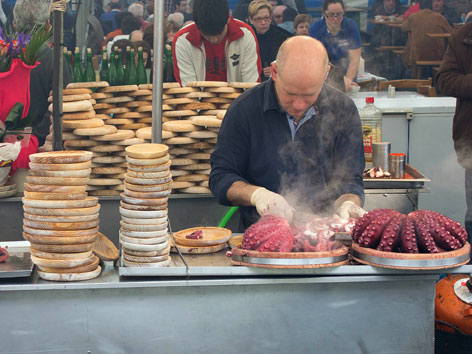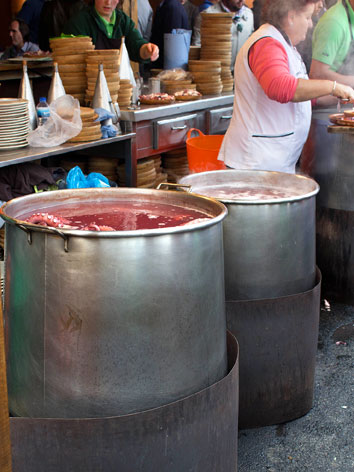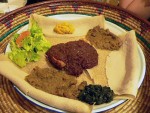
It was a rainy morning, as usual, in Galicia. At the weekly mercado de abastos, bustling with shoppers from nearby villages, a huge tent with communal wood tables and an enormous pile of wooden plates waited for customers to arrive, myself included. Outside, in the entrance, a line of cauldrons bubbled while the pulpeiras dipped pieces of octopus in and out—one, two, three times—before releasing them to the boiling depths. Nearby, a woman sliced up the cooked tentacles, laying them upon the wooden plates; a man next to her finished the dish—called polbo á feira—with a sprinkle of salt and Spanish hot paprika, and a generous drizzle of olive oil. It proved an efficient production-line system for serving the hundreds of ración of polbo that this stand was going to sell that day. I had come to Galicia to explore its gastronomy, and this was the logical place—and plate—with which to start.

A pulpeira slices octopus in Galicia

Boiling cauldrons of octopus
The cuisine of Galicia, the region of northwest Spain bordering the Cantabric Sea in the north and the Atlantic Ocean in the west, boasts a profound sea footprint, represented in wider Spanish gastronomy via foods like mussels, vieiras (scallops), octopus, and the internationally esteemed percebes (goose barnacles). With such raw materials, it’s not surprising that Galicia’s food scene is a tourist attraction in its own right—just ask the thousands of hungry pilgrims arriving to Santiago de Compostela after their journey through the Way of St. James.
While you can find polbo á feira all across Spain as one of the most famous and beloved tapas (its Castilian Spanish name is pulpo a la gallega, “of Galicia”), the so-called “fairy-style octopus” is Galicia’s signature dish. The octopus, boiled and dusted with coarse sea salt, paprika, and olive oil, has to be cooked just right, as the tentacles are quite tough (traditionally, the strong pulpeiras beat them with a rock to tenderize the meat; nowadays, it is enough to freeze the octopus for two weeks or use frozen product). These simple ingredients, far from masking the taste of the sea, serve to enhance it by offering texture and a deliciously deep, salty, earthy flavor.
Polbo á feira
Serves 4
1.5 kg (3.3 lbs) frozen octopus
Olive oil
Coarse sea salt
Spanish hot paprika
1. Let the octopus defrost in the fridge for a few hours or overnight. Place it in a large bowl, as it will release a lot of water. Before cooking, rinse it under running water to clean.
2. In a large pot, place enough water to cover the octopus, and bring it to a boil. Holding the octopus by the head, “scare” it by dipping it three times into the water, so that it will preserve its skin once cooked. Release it and let simmer for 30 to 40 minutes (depending on the octopus’s size, it may take longer—it’s cooked enough if it can be easily pierced with a knife). Achieving the right consistency—not too chewy, not too mushy—may be tricky the first time, but it gets easier!
3. Remove the octopus from the water and, using scissors, slice the tentacles and head into hunks about 1/4 inch thick.
4. Spread the pieces onto a wooden plate, and sprinkle with salt and paprika. Finally, add a generous trickle of high-quality olive oil. Serve with toothpicks, the traditional way.
Note: In some traditional pulperías, the octopus is left whole in the cooking water for a few hours. This has two goals: to finish the cooking process (if it’s still not mushy) and to prevent it from overcooling while the raciones are prepared. You can do this too, if you cook the octopus some hours before serving.
All photos by Cinta Farnós Brull
About the author: Cinta Farnós Brull is a Catalan political scientist and a passionate food blogger and writer, currently living in Barcelona. You can view more of her work at her English and Catalan blog, www.trossetsdecuina.cat.










.jpg)

